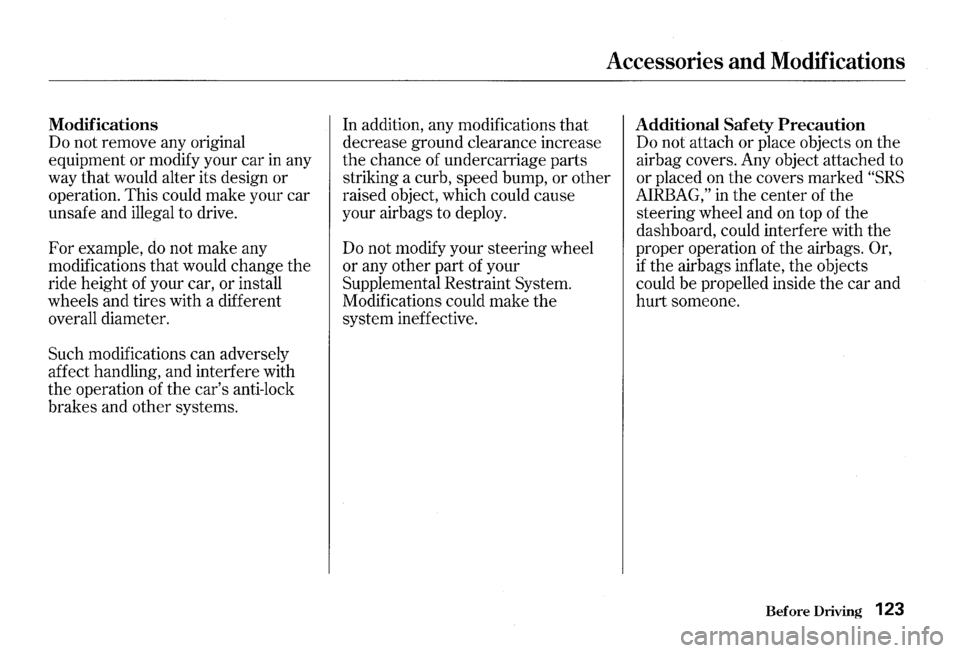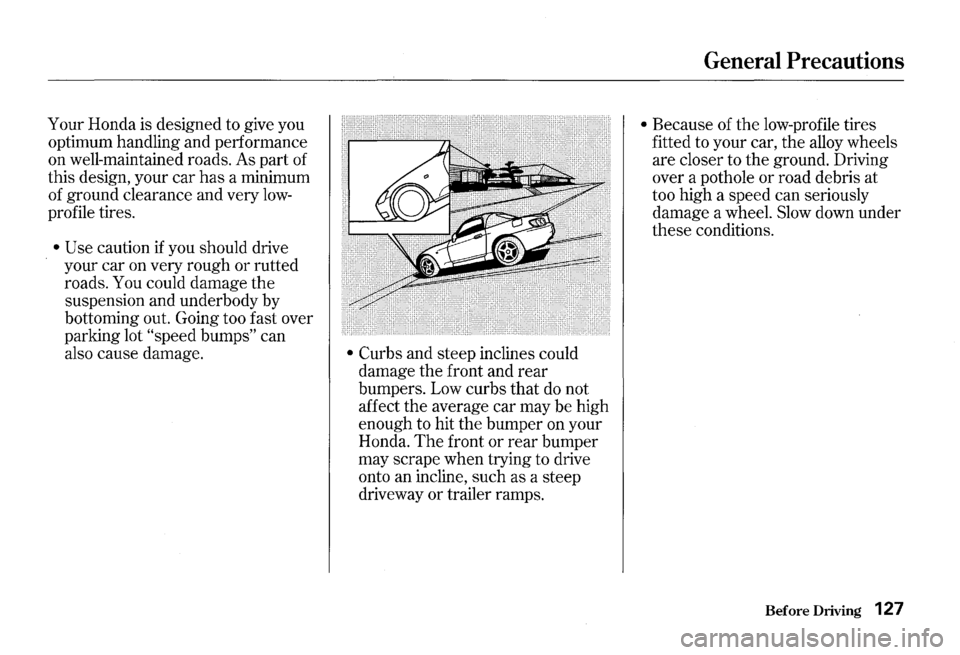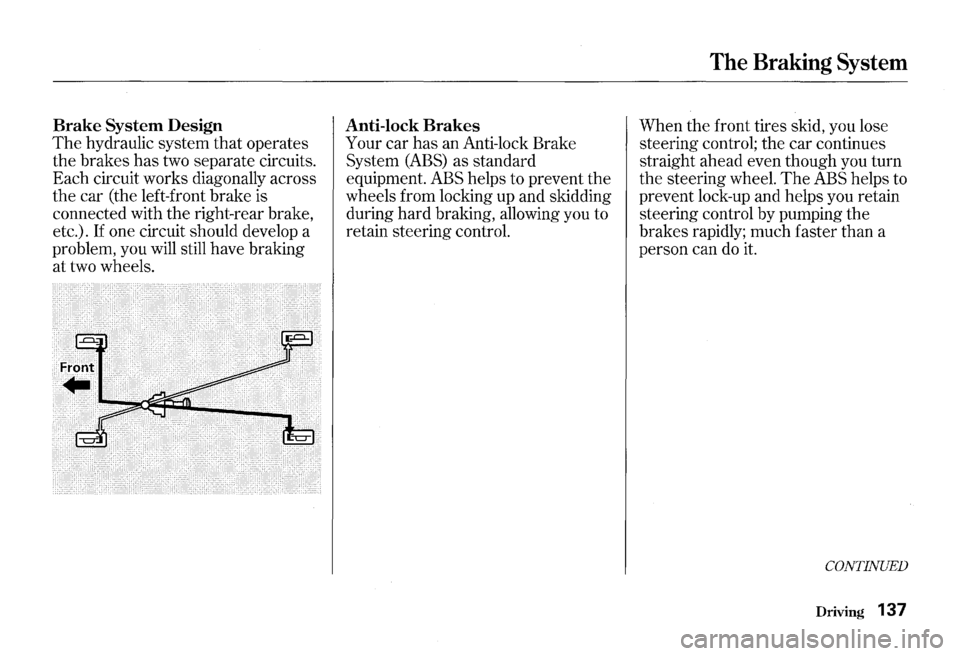2000 HONDA S2000 tires
[x] Cancel search: tiresPage 47 of 273

Indicator Lights
I ~ I Seat Belt Reminder Light
This indicator flashes for several
seconds when you turn
the ignition
0 N (II). It flashes as a reminder to
you and your passenger to fasten
the
seat belts. A beeper also sounds if
you have not fastened your
seat belt.
If you do not fasten your seat belt,
the beeper will stop after a few
seconds
but the light stays on until
you do. Both
the light and the beeper
stay off if you fasten your seat belt
before turning on
the ignition.
44 Instruments and Controls
~ Low Oil Pressure
~ Indicator
The engine can be severely damaged
if this light flashes or stays on when
the engine is running. For complete
information, see page 226 .
~ Charging System
~ Indicator
If this light comes on when the
engine is running, the battery is not
being charged. For complete
information, see page 227 .
U.S. Canada
I BRAKE I I ((D) I
Parking Brake and
Brake System Indicator
This light has two functions:
1. It lights as a reminder that you
have not released
the parking
brake. Driving with
the parking
brake applied can damage
the
brakes and tires.
2. If it remains lit after you release
the parking brake while the engine
is running,
or comes on while
driving, it can indicate a problem
in
the brake system. For complete
information,
see page 229 .
Page 126 of 273

Modifications
Do not remove any original
equipment or modify your car in any
way
that would alter its design or
operation. This could make your car
unsafe and illegal to drive.
For example, do not make any
modifications
that would change the
ride height of your car, or install
wheels and tires with a different
overall diameter.
Such modifications can adversely
affect handling, and interfere with
the operation of the car's anti-lock
brakes and other systems.
Accessories and Modifications
In addition, any modifications that
decrease ground clearance increase
the chance of undercarriage parts
striking a curb, speed bump, or other
raised object, which could cause
your airbags to deploy.
Do not modify your steering wheel
or any other part of your
Supplemental Restraint System.
Modifications could make the
system ineffective. Additional Safety Precaution
Do not attach or place objects on the
airbag covers. Any object attached to
or placed on the covers marked
"SRS
AIRBAG," in the center of the
steering wheel and on top of the
dashboard, could interfere with the
proper operation of the airbags.
Or,
if the airbags inflate, the objects
could be propelled inside the car and
hurt someone.
Before Driving 123
Page 130 of 273

Your Honda is designed to give you
optimum handling and performance
on well-maintained roads. As part of
this design, your car
has a minimum
of ground clearance and very
low
profile tires.
• Use caution if you should drive
your car on very rough or rutted
roads. You could damage the
suspension and underbody by
bottoming out. Going too fast over
parking lot
"speed bumps" can
also cause damage.
• Curbs and steep inclines could
damage the front and rear
bumpers. Low curbs that
do not
affect the average car may be high
enough to hit the bumper on your
Honda.
The front or rear bumper
may scrape when trying to drive
onto an incline, such as a steep
driveway or trailer ramps.
General Precautions
• Because of the low-profile tires
fitted to your car, the alloy wheels
are closer to the ground. Driving
over a pothole or road debris at
too high a speed can seriously
damage a wheel. Slow down under
these conditions.
Before Driving 127
Page 133 of 273

Preparing to Drive
You should do the following checks
and adjustments every day before
you drive
your car.
1. Make sure all windows, mirrors,
and outside lights
are clean and
unobstructed. Remove frost, snow,
or ice.
2. Check that the hood and trunk are
fully closed.
3. Visually check the tires. If a tire
looks low,
use a gauge to check its
pressure.
130 Driving
4. Check that any items you may be
carrying with you inside are stored
properly or fastened down
securely.
5. Check the adjustment of the seat
(see page 68 ) .
6. Check the adjustment of the
inside and outside mirrors (see
page
79 ).
7. Make sure the doors are securely
closed and locked.
8. Fasten your seat belt. Check that
your passenger has fastened his
seat belt (see page 15 ) .
9. Turn the ignition switch ON (II).
Check
the indicator lights in the
instrument panel.
10.Start
the engine (see page 131 ) .
1l.Check the gauges and indicator
lights in
the instrument panel (see
page
43 ).
Page 140 of 273

Brake System Design
The hydraulic system that operates
the brakes has two separate circuits.
Each circuit works diagonally across
the car (the left-front brake is
connected with the right-rear brake,
etc.).
If one circuit should develop a
problem, you will still have braking
at two wheels.
Anti-lock Brakes
Your car has an Anti-lock Brake
System
(ABS) as standard
equipment. ABS helps to prevent the
wheels from locking up and skidding
during hard braking, allowing you to
retain steering control.
The Braking System
When the front tires skid, you lose
steering control; the car continues
straight ahead even though you turn
the steering wheel.
The ABS helps to
prevent lock-up and helps you retain
steering control by pumping the
brakes rapidly; much faster than a
person can do
it.
CONTINUED
Driving 137
Page 141 of 273

The Braking System
You should never pump the
brake pedal, this defeats the
purpose of the ABS. Let the ABS
work for you by always keeping firm,
steady pressure on the brake pedal
as you
steer away from the hazard.
This is sometimes referred to as
"stomp and steer."
You will feel a pulsation in the brake
pedal when the
ABS activates, and
you may
hear some noise. This is
normal, it is the
ABS rapidly
pumping the brakes.
Activation varies with the amount of
traction your tires have.
On dry
pavement, you will need to press on
the brake pedal very
hard before you
activate the
ABS. However, you may
feel the
ABS activate immediately if
you are trying to stop on snow or ice.
138
Driving
Important Safety Reminders
ABS does not reduce the time or
distance it takes to stop the car, it
only helps with steering control
during braking. You should always
maintain a safe following distance
from other vehicles.
ABS will not prevent a skid that
results from changing direction
abruptly, such as trying to take a
corner too fast or making a sudden
lane change. Always drive at a safe,
prudent speed for the road and
weather conditions.
ABS cannot prevent a loss of
stability. Always steer moderately
when you are braking hard.
Severe
or sharp steering wheel movement
can still cause your car to veer into
oncoming traffic
or off the road.
A car with ABS may require a
longer
distance to stop on loose or
uneven surfaces, such as gravel
or
snow, than a car without anti-lock.
Slow down and allow a greater
distance between cars under those
conditions.
Page 144 of 273

Traction -Check your tires
frequently for wear and proper
pressure. Both are important
in
preventing "hydroplaning" (loss of
traction on a wet surface). In the
winter, mount snow tires on all four
wheels for the
best handling.
Watch road conditions carefully,
they can change from moment to
moment. Wet leaves can be as
slip
pery as ice. "Clear" roads can have
patches of ice. Driving conditions
can be very hazardous when the
outside temperature is near freezing.
The road surface can become
covered with areas of water puddles
mixed with areas of ice, so your
traction can change without warning.
Be careful when downshifting. If
traction is low, you can lock up the
drive wheels for a moment and cause
a skid.
Driving in Bad Weather, Towing a Trailer
Be very cautious when passing, or
being passed by other cars.
The
spray from large cars reduces your
visibility, and the wind buffeting can
cause you to lose control.
Towing a Trailer
Your car is not designed to tow a
trailer. Attempting to
do so can void
your warranties.
Driving 141
Page 146 of 273

This section explains why it is
important to keep your car well
maintained and to follow basic
maintenance safety precautions.
This section also includes
Maintenance Schedules for normal
driving and severe driving conditions,
a Maintenance Record, and instruc
tions for simple maintenance tasks
you may want to take care of
yourself.
If you have the skills and tools to per
form more complex maintenance
tasks on your Honda, you may want
to purchase
the Service Manual. See
page 259 for information on how to
obtain a copy,
or see your Honda
dealer. Maintenance
Safety .......................
144
Important
Safety Precautions .. 145
Maintenance Schedule .................. 146
Required Maintenance Record
.... 153
Owner Maintenance Checks ........ 155
Fluid Locations ............................... 156
Engine Oil ....................................... 157
Adding Oil... ................................ 157
Recommended Oil ..................... 157
Synthetic
Oil ............................... 158
Additives ..................................... 158
Changing the Oil and Filter.. .... 159
Cooling System .............................. 161
Adding Engine Coolant ............. 161
Replacing Engine Coolant ........ 163
Windshield Washers ..................... 167
6-speed Manual Transmission
Fluid ............................................
168
Differential Fluid ........................... 169
Brake and Clutch Fluid ................. 170
Brake Fluid ................................. 170
Brake System ............................. 170
Clutch System ............................ 171
Air Cleaner Element.. .................... 172
Hood Latch ..................................... 174
Maintenance
Spark Plugs ..................................... 174
Replacement ............................... 17 4
Specifications ............................. 176
Battery ............................................
177
Wiper Blades .................................. 180
Air Conditioning System ............... 182
Air Conditioning Filter, ................. 183
Drive Belt ........................................ 184
Tires ................................................ 185
Inflation ....................................... 185
Inspection ................................... 187
Maintenance ............................... 188
Tire Rotation .............................. 188
Tire Wear .................................... 188
Replacing Tires and Wheels .... 189
Wheels and Tires ....................... 190
Winter Driving ........................... 190
Snow
Tires .............................. 191
Tire Chains ............................. 191
Lights .............................................. 192
Replacing Bulbs ......................... 194
Storing Your Car ............................ 202
Maintenance 143